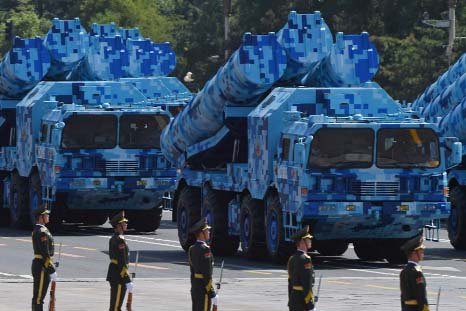
AP, Beijing :
China’s leader presided over a parade of tanks, missiles and troops that displayed growing military might Thursday as fighter jets roared overhead, but pledged a 300,000 reduction in troops in a bid to show his country poses no expansionist threat.
The massive parade through the heart of Beijing commemorated Japan’s World War defeat seven decades ago, with helicopters zooming across the sky in an array forming the number 70, but the event also underlined President Xi Jinping’s determination to make China the pre-eminent Asian power.
Xi kicked off the proceedings with a speech at the iconic Tiananmen Gate in the heart of Beijing, flanked by Chinese leaders and foreign dignitaries, including Russian leader Vladimir Putin, South Korean President Park Geun-hye and U.N. Secretary General Ban Ki-moon.
“The experience of war makes people value peace even more,” Xi said. “Regardless of the progress of events, China will never seek hegemony, China will never seek to expand and will never inflict the tragedies it suffered in the past upon others.”
To underline that point, Xi said the 2.3-million-member People’s Liberation Army would cut 300,000 troops to about 2 million. However, it would still remain the world’s largest standing military and the reduction comes at a time when growing technological capabilities reduce the need for large numbers of troops.
Xi then drove past the assembled troops in a Chinese-made Red Flag limousine, standing up through a sunroof with four microphones mounted in front of him, calling out “Greetings, Comrades” every few moments, before the troops started their marching.
The spectacle involved more than 12,000 troops, 500 pieces of military hardware and 200 aircraft of various types, representing what military officials say is the Chinese military’s most cutting-edge technology.
The parade is part of commemorations packaged to bolster the ruling Communist Party’s self-declared role as the driving force behind Japan’s defeat 70 years ago and savior of the nation, though historians say the rival Nationalists did most of the fighting. The events also minimize the role of the U.S., Britain and others.
Most leading democracies kept high-level representatives away, reflecting concerns over the parade’s anti-Japanese tone and China’s recent aggressive moves to assert territorial claims. The U.S. sent only its ambassador to observe. In Washington, U.S. Defense Department spokesman Bill Urban said that the U.S. maintains such commemorations should be about reconciliation and that a “large military display would not appear to be consistent with this theme.”
Under Xi, who took power as party leader in late 2012, Beijing has sent ships to confront Japan’s coast guard near disputed islands in the East China Sea, blockaded Philippine island outposts and constructed whole islands from reefs, topping them with airstrips and other military infrastructure.
China’s leader presided over a parade of tanks, missiles and troops that displayed growing military might Thursday as fighter jets roared overhead, but pledged a 300,000 reduction in troops in a bid to show his country poses no expansionist threat.
The massive parade through the heart of Beijing commemorated Japan’s World War defeat seven decades ago, with helicopters zooming across the sky in an array forming the number 70, but the event also underlined President Xi Jinping’s determination to make China the pre-eminent Asian power.
Xi kicked off the proceedings with a speech at the iconic Tiananmen Gate in the heart of Beijing, flanked by Chinese leaders and foreign dignitaries, including Russian leader Vladimir Putin, South Korean President Park Geun-hye and U.N. Secretary General Ban Ki-moon.
“The experience of war makes people value peace even more,” Xi said. “Regardless of the progress of events, China will never seek hegemony, China will never seek to expand and will never inflict the tragedies it suffered in the past upon others.”
To underline that point, Xi said the 2.3-million-member People’s Liberation Army would cut 300,000 troops to about 2 million. However, it would still remain the world’s largest standing military and the reduction comes at a time when growing technological capabilities reduce the need for large numbers of troops.
Xi then drove past the assembled troops in a Chinese-made Red Flag limousine, standing up through a sunroof with four microphones mounted in front of him, calling out “Greetings, Comrades” every few moments, before the troops started their marching.
The spectacle involved more than 12,000 troops, 500 pieces of military hardware and 200 aircraft of various types, representing what military officials say is the Chinese military’s most cutting-edge technology.
The parade is part of commemorations packaged to bolster the ruling Communist Party’s self-declared role as the driving force behind Japan’s defeat 70 years ago and savior of the nation, though historians say the rival Nationalists did most of the fighting. The events also minimize the role of the U.S., Britain and others.
Most leading democracies kept high-level representatives away, reflecting concerns over the parade’s anti-Japanese tone and China’s recent aggressive moves to assert territorial claims. The U.S. sent only its ambassador to observe. In Washington, U.S. Defense Department spokesman Bill Urban said that the U.S. maintains such commemorations should be about reconciliation and that a “large military display would not appear to be consistent with this theme.”
Under Xi, who took power as party leader in late 2012, Beijing has sent ships to confront Japan’s coast guard near disputed islands in the East China Sea, blockaded Philippine island outposts and constructed whole islands from reefs, topping them with airstrips and other military infrastructure.

